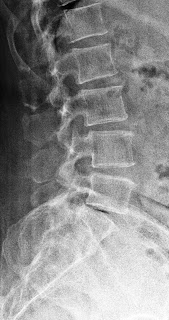Mr Glory Chinda turned out to be one of the most interesting patients I have ever had. This gentleman was seen recently and
underwent surgical intervention for severe back and left leg pains. The
39 year old father of four came from PortHarcourt to Abuja. This is like
internal medical tourism in Nigeria. He said he had read an article about a
woman with back pains and the description was exactly like his symptoms. In
other words, the pain in his left leg was like electric shocks, akin to a
million pins being stuck in his leg. The leg pain is what we call sciatica.
He presented with electric
pains in the whole of the left leg due to a disc prolapsed at L4/L5 causing
significant narrowing of the spinal canal through which all his nerves travel.
This had been ongoing for 6 months and interfering with his life. Sleeping,
walking, sitting, standing and work were all affected by unrelenting pain in
the leg. Even pain killers only lasted a few hours in ameliorating the pain.
We reviewed the MRI scans
performed at Lifebridge Diagnostic Centre in Garki. He had a huge disc prolapse
which required surgical intervention. The operation was performed successfully at
Garki Hospital, Abuja and he recovered well.
Post
surgery care and recovery
He noticed immediate
improvement in the back and leg pains. His walking ability and comfort had also
improved significantly. The specific instructions for similar patients are that
they need to take things easy for about 8 weeks following the operation. This
is a major spine operation though with good early recovery. However, disc
prolapses can recur so patients need to take things easy and allow healing to
be completed before undertaking serious work again.
Also, physiotherapy and back
care instructions are important. No heavy lifting and no sitting for prolonged
periods. In fact, one surgeon tells his patients not lift anything heavier than
a cup of tea.
Most patients are anxious to
return to work but this should be phased. I often caution against an early
return to active duty. When they return to work, it should be to undertake light
duties for a few hours a day and no more. Then a reassessment is done before
commencement of full duty requirements.
Medical tourism
The diagnosis and treatment in
this case was carried out within 24 hours. This is much less than the time it
takes to get a visa and travel hundreds of miles to another country. It means
that he obtained relief from his pains in a short time and so can start the
healing process early. There are some illnesses such as spinal cord injury and
nerve compression requiring immediate medical attention that cannot wait for
the flight to other countries. Also post operative follow up and care is
assured locally.
The key issues are that medical
tourism is eroding the fabric of our own health services and further depleting
the nation of medical facilities and expertise. It demoralises local medical
practitioners and increases the brain drain. It reduces training of medical
students, further creating substandard and poorly trained doctors to look after
us all in the future. It simply creates a vicious circle we must break free of.
The colossal sum of money spent
abroad could be used to equip more local hospitals in Nigeria to perform even
more in delivering care. We need to develop our local hospitals and help
prepare them to be able to help when it really matters. Supporting the local
hospitals and ensuring that it has both personnel and equipment may be the
difference between life and death. Many patients have gone to other countries
and return dead or injured despite colossal sums of money spent.
Spine: Fixed in Abuja
There are several good quality
diagnostic centres in Abuja. Medicaid, King’s Care Hospital, Primus International
Hospital, and Lifebridge Diagnostic Centre are all well equipped with CT and
MRI for diagnosis of spinal conditions.
The operations on the spine can
also be conveniently carried out at many hospitals including the National
Hospital, Garki Hospital, University of Abuja Teaching Hospital, Wellington
Neurosurgery and Asokoro General Hospital. This is because there are trained
surgeons in Abuja offering specialised spine care with a full surgical team
backup and all the necessary equipment. Neck and back pains can be conveniently
managed in Abuja and Abuja is set to be the destination for Nigerians with
spine trauma and degenerative diseases.
Spine: Fixed in Nigeria
Many cases of effective and
efficient management of cases of spine problems abound in Nigeria. Patients do
not need to continue to troop out to other countries in search of quality of
care. At least for spine, we can now boast of the capability to manage most
cases of spine problems to very high standards in Nigeria. There are surgeons
in Sokoto, Enugu, Abuja, Lagos and Ibadan making huge strides in providing
quality care.
As usual, lack of information on
what is available locally impairs access to care. You need to know that the
future is bright, for patients with spine problems. Spine problems should no
longer be a reason to travel out of Nigeria.
This article has been published
with the kind permission of Mr Glory Chinda.
Pictures and legend
x-rays of normal lumbar spine, and the other two of a patient who had a fixation with pedicle screws and rods.






